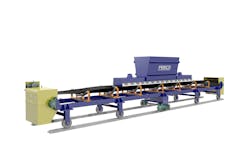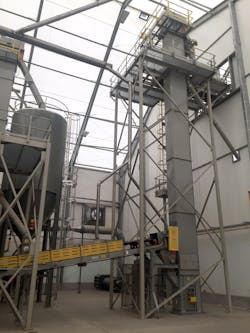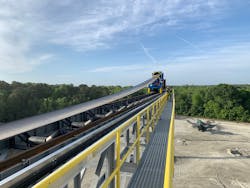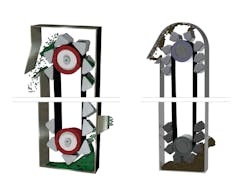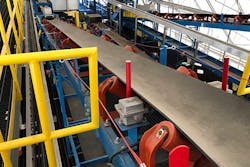
Whether you are conveying material between process equipment, moving it to storage or loading it out to shipping, a well-designed bulk material handling system can mean the difference between reliable, seamless operation and frequent process upsets and downtime. It also often means the difference between a clean handling operation and one subject to excessive fugitive material and associated problems.
The key to obtaining equipment that will perform efficiently and reliably for a lifetime lies in understanding the functionality behind each equipment type and being able to tailor the system to the specific material and facility demands.
What follows is a basic introduction to the most common types of bulk material handling equipment and how each type can be customized to suit various handling needs.
Bulk solids handling equipment types
A range of bulk material handling equipment types are available on the market for mechanical conveying, but a few key types can typically cover the majority of applications thanks to their flexibility and potential for customization.
Troughed belt conveyors
Troughed belt conveyors (or troughing conveyors) represent the most fundamental type of bulk solids handling equipment: a horizontal carrying surface (the belt) that moves between a start point and an end point (tail and head pulley, respectively).
Incredibly flexible and available in a wide range of sizes and capacities, as well as different structural frame styles, troughed belt conveyors are the material handling standard for straightforward applications in which material must be brought from one area to another. This type of conveyor can carry materials at angles ranging from 0° to 20° from horizontal, or up to 30° with special belting.
It is important to note that a troughed belt conveyor is distinctly different from a standard belt conveyor. Unlike a standard belt conveyor, in which the belt rests on flat rollers or an otherwise flat surface, the belt of a troughing conveyor is supported by angled idlers. This creates a concave surface or “trough” in which material rides during handling, helping to prevent spillover and agitation or aeration of the material during conveying.
Troughed belt conveyors are employed for carrying everything from fertilizers and chemicals to minerals and aggregates.
Reversing shuttle conveyors
Similar to troughed belt conveyors, reversing shuttle conveyors also consist of a belt conveyor on idlers between pulleys, but instead of being mounted to a stationary frame, the conveyor is mounted on a rail system.
Combined with a belt that can move in both directions, this rail-mounted conveyor is ideal for situations that require evenly filling multiple hoppers or bins, or in storage settings where the equipment is tasked with creating a continuous in-line pile.
This type of conveyor uses a stationary inlet to provide a central feed location that eliminates the need for complex chute systems or diverters.
Steep incline conveyors
Steep incline (or pocket belt) conveyors are used in situations where vertical conveying is necessary, such as when moving material between floors of a facility. Unlike troughed belt conveyors that can only reach angles up to 30° from horizontal, steep incline conveyors can carry material at angles all the way up to 90°.
To do so, steep incline conveyors employ corrugated sidewall belting with evenly spaced cleats along the belt. The corrugated sidewalls help to contain material horizontally on the conveyor, while cleats help to contain it vertically, essentially creating “pockets” in which material rests during conveying to prevent fallback. These pockets are why this conveyor is also known as a pocket belt conveyor.
Because steep incline conveyors can be configured to incorporate vertical and horizontal conveying through “L” and “S” shaped designs, they can be used to replace multiple pieces of equipment while also minimizing transfer points. This makes them a favored option in facilities limited on space. Their ability to limit transfer points also makes them ideal when handling fragile materials or materials that must not be aerated.
Bucket elevators
Bucket elevators are the standard choice for high-capacity vertical conveying, capable of operating at much higher throughputs than steep incline conveyors.
Bucket elevators consist of multiple buckets mounted onto either a belt or chain (or dual chains for super-capacity operations) inside a stationary casing. The belt or chain rotates around a head pulley at the top and a boot pulley at the bottom, picking up material in the boot and discharging it at the head. The enclosed casing limits fugitive material around the unit.
Depending on the material, bucket elevators can be configured to be either centrifugal or continuous, which references their feeding and discharge styles.
Tailoring equipment for optimal performance and longevity
Each of these four types of bulk material handling equipment allows for a high level of customization, covering the majority of handling applications required by most plants. Customization gives plant managers the ability to tailor a piece of equipment or complete system to their specific facility and material requirements and may be done either by incorporating additional components or by customizing a base unit’s standard components.
Additional components for troughed belt conveyors
Troughed belt conveyors can include a number of additional components to improve upon the base conveyor’s functionality. Most often, this is done by incorporating the following:
Belt plows. A belt plow consists of a pneumatically actuated plow blade that can discharge material from one or both sides of the conveyor at fixed points along its length.
Belt trippers. A belt tripper also increases discharge points on one or both sides of the conveyor but, unlike a belt plow, can be fixed or movable, adding to the conveyor’s flexibility. The tripper can also discharge material continuously at a constant speed, for layered stacking in large storage structures.
Both trippers and plows can be automated for improved system control.
Belt feeders. A belt feeder can be incorporated into a conveyor to introduce material to the system at a controlled rate from a bin or hopper. This allows for a consistent feed rate from an otherwise uncontrolled feeding source.
A number of other components are available to improve functionality as well, including metal detectors for detecting tramp metal, magnets for removing tramp metal, belt scales to continuously monitor mass flow rates, and more.
Add-on components are less common for steep incline and reversing shuttle conveyors; steep incline conveyors may incorporate metal detectors and magnets, but the mobility of shuttle conveyors does not typically allow for this.
All types of conveyors may also incorporate various guards and instrumentation to improve safety and functionality.
Customizations for conveyors
In addition to the increased functionality that can be achieved through the incorporation of belt plows, trippers, and feeders, every aspect of the conveyor itself can be customized to suit the specific requirements of a given facility and material.
The choice to customize equipment typically depends on the conveyed material’s characteristics, such as corrosiveness, abrasiveness, particle size distribution (PSD), moisture content, fragility, and potential for dust generation, among many others.
These factors can influence the selection and configuration of components such as idlers, belt type, drive assemblies, cleaners, and more.
Idlers for troughed belt and shuttle conveyors are available in a number of different materials of construction and configurations (such as impact, training, flat return, etc.), both of which can be used to protect the belt from damage and discourage idler degradation while also helping to transition conveyors around equipment and infrastructure.
Conveyor belting is available with various cover compounds to address material-specific challenges, including heat-resistant, moderate oil-resistant (MORS), raised profile, flame retardant, solar resistant, and chemical resistant.
Drive assemblies can be configured for reliability and longevity based on several factors, including material moisture content, particle size distribution, loading, and more.
Belt cleaners, applicable only to troughed belt and shuttle conveyors, are used to minimize carryback (material “carried back” on the belt’s return side). Carryback can cause a number of issues, including belt misalignment, belt damage, idler degradation, pulley damage, and more.
Various belt cleaner options are available depending on the level of cleaning required. This includes single belt cleaners, dual belt cleaners, v-plows, and self-cleaning tail pulleys. In cases where minimizing carryback and fugitive material around the conveyor is especially critical, such as when working with a highly sticky or corrosive material, multiple types of cleaners can be incorporated.
For steep incline conveyors, producers can enlist the help of a belt thumper to minimize buildup on steep incline conveyor belting.
Numerous other customizations can be incorporated to address spatial limitations, accessibility, maintenance needs, and more. This includes different options for take up assemblies (belt tensioners), the inclusion of ladders, walkways, and service platforms, as well as weather covers and gallery enclosures for protecting material and conveyors from the elements in outdoor settings.
Customizations for bucket elevators
Bucket elevators can also be customized in various ways, depending on facility and material requirements. The most common ways of customizing bucket elevators include the following.
Centrifugal or continuous configuration. A continuous bucket elevator is used in settings where gentle handling is required, such as when handling fragile materials or those that are prone to aeration. This configuration employs gentle feeding and discharge.
In settings where more aggressive handling is tolerable, and particularly when handling at higher capacities, centrifugal-style elevators are employed. These conveyors scoop material from the boot as the buckets pass around the tail pulley. At the head section, the buckets “throw” material into the discharge chute via centrifugal force as they pass over the head pulley.
Belt or chain. Buckets can be mounted onto either a belt or chain. Belts are more economical but are not suitable for higher-capacity settings, for hot or combustible materials, or for particle sizes that are large enough to become lodged between the belt and buckets. Chains offer a high-capacity, heavy-duty option but may not be a fit when corrosion is a concern.
Bucket style. Buckets are available in several different materials of construction and styles, depending on the material requirements and whether the elevator will be centrifugal or continuous.
Accessibility. As with conveyors, bucket elevators can be provided with numerous modifications and accessories to improve their accessibility. This includes inspection and access doors, ladders and safety cages, maintenance platforms, and more.
Conclusion
Understanding the functionality of each type of bulk material handling equipment as well as its ability to be customized is essential to engineering a seamless handling system, regardless of the material being handled.
Troughed belt conveyors, shuttle conveyors, steep incline conveyors, and bucket elevators cover a wide range of bulk material handling needs, with significant opportunity to improve their functionality and longevity through custom configuration.
Dan Baxter is in material handling sales at FEECO International.
